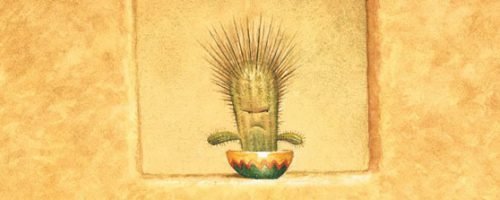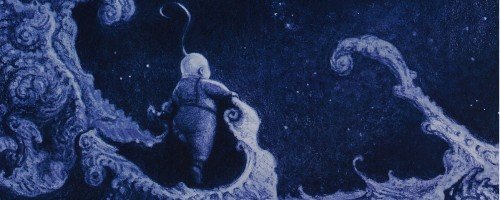Many years ago, a former boss gave everyone on her team a cactus just before the Christmas break. It was an unusually pointy gift, and my suspicion about its inherent symbolism was confirmed a year later, when we all received knock-off Swiss army knives. Stay away – I am prickly. The fact that we already knew this about her was not the point, no pun intended. For some reason, she wanted to give us tiny versions of herself. We got the message, and we obliged.
In Nobody Hugs a Cactus by Carter Goodrich, the main character – Hank, the aforementioned succulent, is indeed, very prickly, and boy oh boy he does not want anyone or anything to come near. He is content to sit in his window perch, alone, staring out into the “hot, dry, peaceful and quiet” desert landscape.
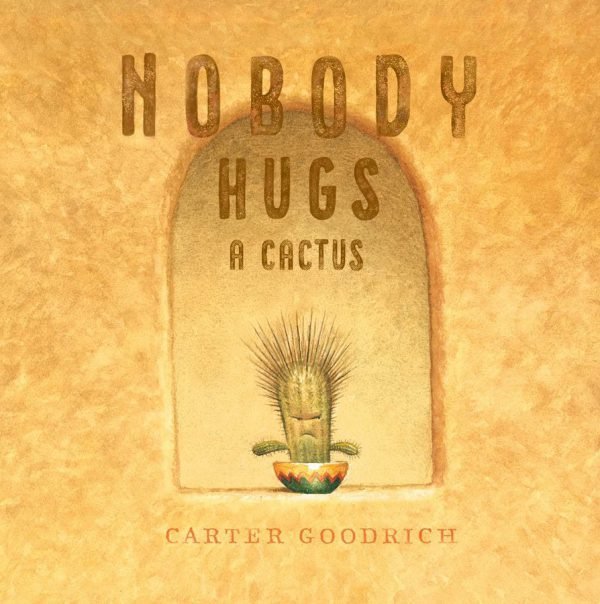
Hank watches suspiciously as a parade of well-meaning critters of the animal, reptile, human and tumbleweed variety pass by, all of whom try to woo Hank out of his self-imposed isolation. They are rebuffed, one by one.
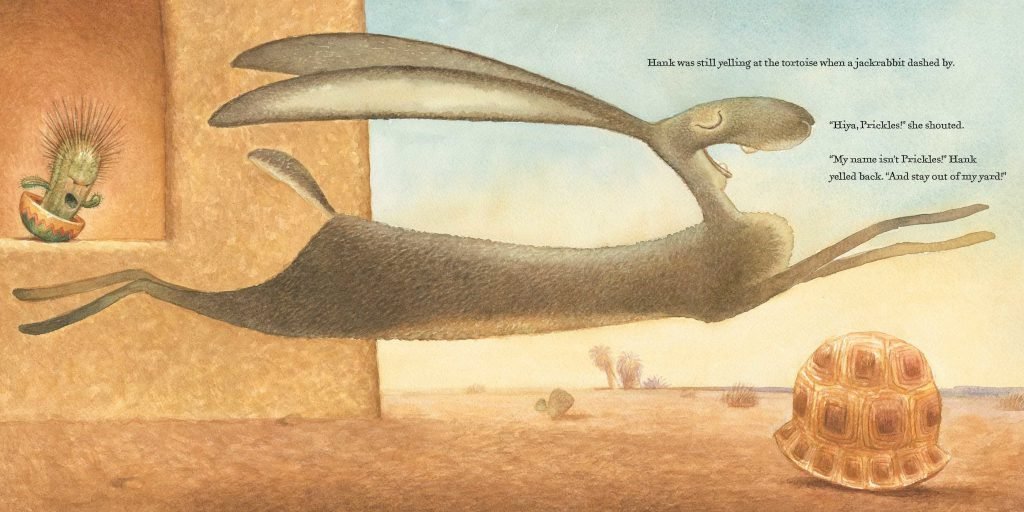
It’s a cowboy, striding in on hilariously long legs, who first suggests to Hank that he might need a hug, but then adds, “Too bad nobody hugs a cactus.”
One gets the impression that Hank may not know what a hug is, but whatever it is, he doesn’t want it, and so he doubles down on his next insult to a skittering lizard. “Just in case you’re wondering, I don’t want a hug.” The lizard is only too happy to comply. “That’s good, because I don’t want to give you one.” The tables have now turned, and it’s the visitors who reject Hank. A little hurt by the lizard’s remark, he begrudgingly offers to hug an owl, who abruptly turns him down.
For the first time, Hank feels lonely.
We don’t always know what we need, or we do and we fear asking for it. In choosing a cactus with all its barbs and pointy spines to convey vulnerability, Goodrich is suggesting that underneath even the strongest, most impenetrable armour, there is always something soft. Something that needs attention. Lucky for Hank, in a moment of distress – amusing to the reader but not so much for Hank – he is rescued, literally and figuratively, by Rosie, a cheerful tumbleweed.
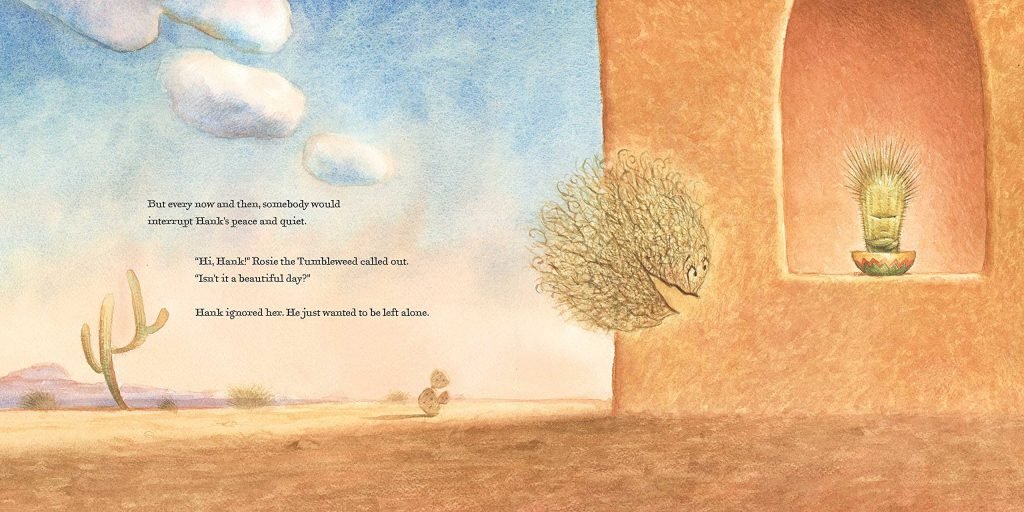
The way he thanks his new friend, by growing a flower for her, is the reason I bought this book. This illustration is so hopeful, so beautiful, so full of heart. The posture of his arm, outstretched, with “the best flower he could grow” is Goodrich at his best. He is able to convey feeling without being cloying or manipulative. His illustrations often make me laugh – and one with a jackrabbit made me laugh out loud in the bookstore – but they also make me love. Deeply. When he unveils this flower, I love Hank. And readers will love Hank. He is trying, very, very hard to make a connection. In opening up to kindness, Hank himself becomes kind.
This is not the end of the story, but suffice to say, Hank is a changed cactus.
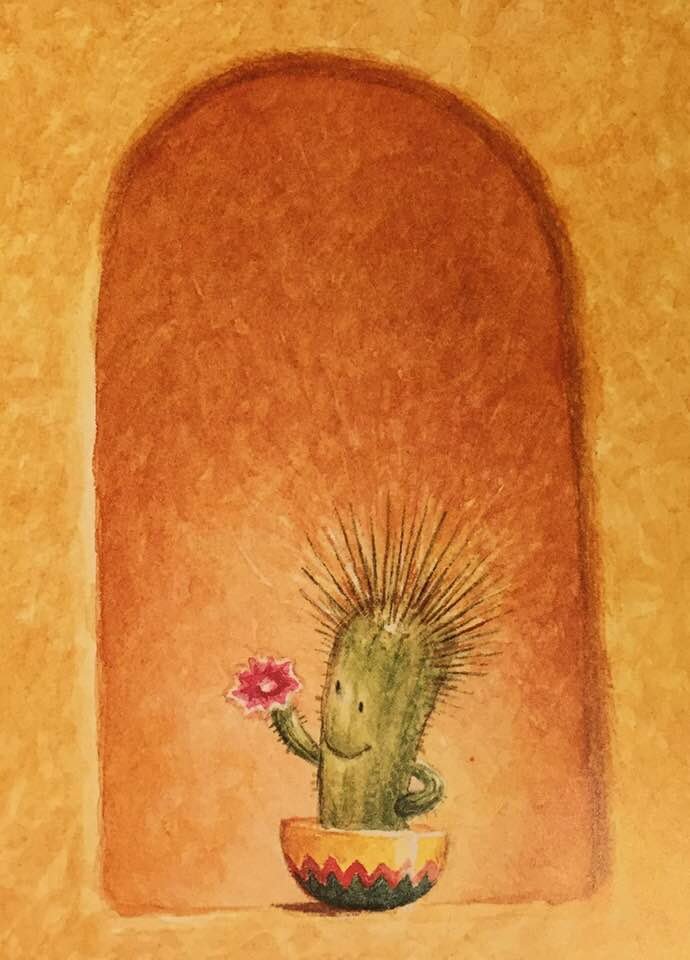
In Nobody Hugs a Cactus, Goodrich paints the desert background in golden watercolour washes, the details diffuse, focusing instead on the wild array of characters who populate the otherwise sparse landscape. Expression, posture, emotion – this is Goodrich territory. With a deft hand and an empathetic heart, he imbues his characters, even a small, ornery cactus, with such lovableness, it is impossible not to care. This succulent may be prickly, but as Goodrich knows, it’s all surface. Bring it in, Hank.
I have long been a fan of Carter Goodrich. My entry drug was his beautiful and often politically barbed covers for the New Yorker, but it’s his trilogy of books featuring two dogs, Mister Bud and Zorro, that made me fall in love with this two-time Society of Illustrators gold medal winning illustrator. No surprise, Goodrich is also a character designer for such films as Brave, Despicable Me and Ratatouille, for which won the International Animated Film Society’s Annie Award for character design.
Nobody Hugs a Cactus by Carter Goodrich. Published by Simon & Schuster, 2019.
Check out Carter Goodrich’s website here.
Read my review of Mister Bud Wears the Cone
Read my review of Zorro Gets an Outfit
Read my review of Say Hello to Zorro!
